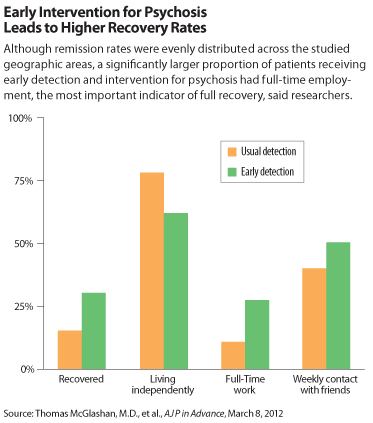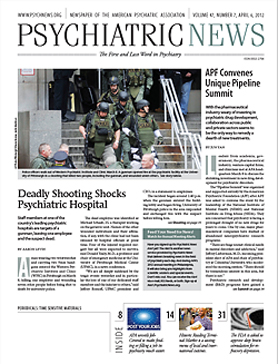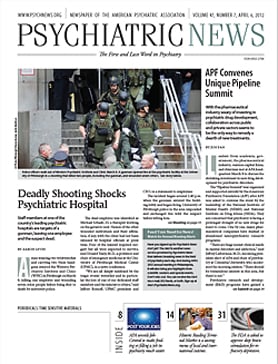Clinical benefits of early detection of schizophrenia previously seen at two and five years appear to persist into the 10th year after initial diagnosis, according to a study reported online in AJP in Advance on March 8.
A significantly higher number of individuals who received early intervention for a first-episode psychosis fulfilled recovery criteria than did individuals receiving usual care. Early-detection patients were significantly more likely to be employed full time, one of the most important indicators of recovery.
The 10-year results were from the Treatment and Intervention in Psychosis Study (TIPS), which had previously reported benefits of early detection at two and five years.
“What’s new and different about this study is that the positive results that we have already seen at two and five years appear to stand the test of time,” said co-author Thomas McGlashan, M.D., a pioneer in early detection of schizophrenia and professor emeritus of psychiatry at Yale School of Medicine. “I think it raises the reasonable hypothesis that the positive clinical differences we see at 10 years are associated with the earlier timing of intervention, and that the positive benefits are permanent.”
In the study, which was begun in 1997, two sectors in Rogaland County, Norway, instituted a public-education and outreach campaign aimed at rapid detection and early treatment of first episode of psychosis. The Ullevaal Health Care Sector in Oslo County, Norway, and the mid-sector, Roskilde County, Denmark, made up the usual-detection areas.
The early-detection program combined information campaigns about psychosis with easy access to mental health care. Patients from both geographic areas were treated according to a two-year standard treatment protocol that included antipsychotic medication, supportive psychotherapy, and multifamily psychoeducation. As described in a November 2001 article in the American Journal of Psychiatry titled “Shortened Duration of Untreated First-Episode Psychosis: Changes in Patient Characteristics at Treatment,” the duration of untreated psychosis was reduced in the early-detection area from a median of 26 weeks to five weeks, while the usual-detection area had a median of 16 weeks.
Recovery was defined as meeting criteria for both symptom remission, using the Positive and Negative Syndrome Scale, and adequate functioning, using three subscales of Strauss-Carpenter Level of Function Scale measuring independent living, role functioning, and social interaction.
McGlashan and colleagues found that a significantly higher number of early-detection patients (30.7 percent) fulfilled recovery criteria at 10 years compared with usual-care patients (15.1 percent; see chart). Although remission rates were evenly distributed across the areas, a significantly larger proportion of patients in the early-detection area had full-time employment—27.7 percent compared with 11.0 percent receiving usual care.
William Carpenter, M.D., chair of the DSM-5 Work Group on Psychotic Disorders, called the study results “remarkable” and said implications for secondary and tertiary prevention are profound. “Public education led to earlier detection of symptoms of nonaffective psychoses,” he told Psychiatric News. “This in turn enabled clinical intervention with long-lasting benefit compared with similar persons who came to clinical attention later in illness onset in areas without the public education.
“Critics of early detection of psychosis are concerned that non-ill young people will be stigmatized, with more harm than good resulting,” Carpenter said. “The TIPS study demonstrates that public awareness can lead to earlier detection of psychopathology and that the effect is beneficial in terms of long-term functional outcome.”
McGlashan drew attention to the importance of employment as a variable in the results, particularly as an indicator of the effect of early intervention on negative symptoms. He noted that lack of initiative and other negative symptoms, which are considered the most intractable in schizophrenia, likely represent the loss of neurons resulting from untreated psychosis.
“Positive symptoms are a manifestation of overactive mini-circuits in the brain, while negative symptoms represent underactivity because of the loss of connectivity,” he said. “Psychosis has both, and employment requires a change in both. You can’t work side by side with someone if you are paranoid, but you also can’t work if you don’t have initiative. We feel early identification and intervention may address both.”



